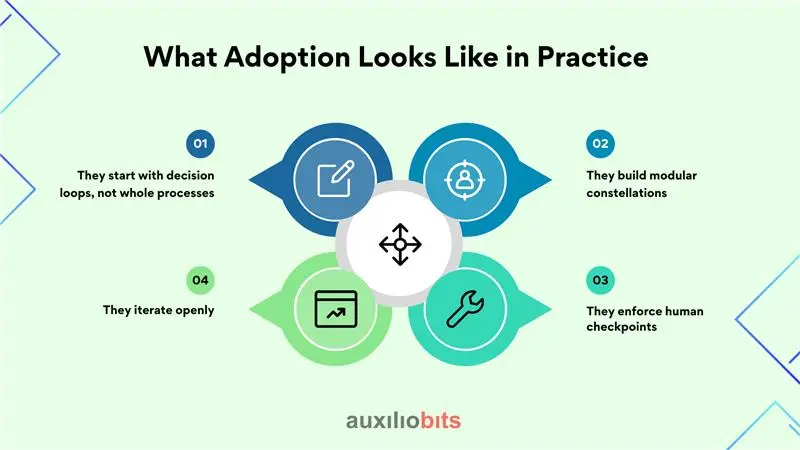
Key Takeaways
- Volatility becomes an advantage with adaptive intelligence. Emerging markets are inherently unstable, but agentic AI thrives in that fluidity—learning, adjusting, and reacting faster than static automation ever could.
- Agentic systems scale cognition, not just labor. Instead of automating repetitive tasks, they replicate decision logic—giving organizations the ability to scale thinking capacity without inflating headcount.
- Adoption works best incrementally. Successful companies begin with narrow decision loops, add modular agents, and grow capability step by step—avoiding high-risk, top-down deployments.
- Culture determines success more than code. Teams that view AI agents as collaborators rather than competitors gain faster acceptance, smoother governance, and stronger performance gains.
- Emerging markets may outpace developed ones. With fewer legacy constraints and higher urgency for ROI, developing economies can leapfrog traditional automation paths, positioning agentic AI as a true strategic differentiator.
A quiet shift is happening in how businesses in emerging economies think about automation. For years, “digital transformation” mostly meant installing software—ERPs, CRMs, RPA tools—and hoping they’d iron out inefficiencies. They helped, but only so much. The next leap forward isn’t another dashboard or workflow engine. It’s the arrival of agentic AI—AI entities that act, decide, and collaborate without needing a constant human hand.
At first glance, this might sound futuristic or even impractical. But oddly enough, it’s in the world’s most volatile markets—India, Indonesia, Kenya, Brazil, the Philippines—where agentic AI is showing the strongest, fastest impact. The same unpredictability that used to make these economies hard to automate is now turning into their competitive edge.
Also read: Creating the Digital Nerve Center of Tomorrow with Agentic Workflows
The Context: Why These Markets Move Differently
Emerging markets are not smaller versions of developed ones. They’re a different organism altogether—leaner and faster in some areas but constrained in others. Supply chains zigzag through informal networks, regulations shift faster than software upgrades, and customer behavior rarely fits neat Western patterns.
Automation built for stability struggles here. A bot can copy-paste data from invoices all day long, but what happens when the vendor changes the invoice format next week, or when half the data arrives through WhatsApp screenshots?
That’s the daily reality.
Agentic systems—by design—are more adaptive. They don’t rely on fixed triggers. They interpret, plan, and re-plan. They reason about goals and constraints, not just steps. Which makes them oddly well-suited to economies where chaos is the default operating condition.
Why Agentic AI Feels Almost Native to Emerging Economies
Most emerging-market businesses have had to improvise for decades. Systems often lag behind business reality. Processes depend on human ingenuity more than documentation. Agentic AI doesn’t replace that—it formalizes it.
We have mentioned all the reasons why it thrives here:
1. Volatile environments reward flexibility
In certain places, things can change mid-week: import rules, fuel costs, or even political situations. Companies can’t afford to “wait for IT” every time a workflow breaks. Agents can sense new conditions—say, a pricing anomaly or delayed shipment—and adjust tactics autonomously. That kind of fluidity isn’t a luxury here; it’s survival.
2. Scarce talent drives smarter augmentation
Certain kinds of expertise—financial analysis, compliance review, data science—are simply scarce. And hiring globally isn’t always affordable. Agentic AI takes on the repetitive interpretive loops—risk scoring, data validation, supplier evaluation—so the human experts focus on judgment, not drudgery.
3. Uneven digital maturity is an advantage
Legacy-heavy organizations in the West often find agentic AI hard to deploy—too many locked-down systems, too many “frozen” data architectures. But many firms never built such rigid layers. They’re agile by necessity.
One manufacturing firm connected agents directly to their supplier chat systems—no middleware, no ERP plugin—and saw results in weeks. When you don’t have to untangle old wiring, innovation moves faster.
4. The economics reward immediate payback
Executives in these regions don’t have patience for hype cycles. They need payback in quarters, not years. That pressure weeds out wasteful projects and forces a laser focus on ROI. Agentic AI fits that model because it tends to start small—an agent that negotiates or one that validates invoices—and compounds impact over time.
The Edge: How Agentic AI Changes Competition
1. Speed without burnout
A human team can’t monitor 200 variables in real time. Agents can. When conditions shift—supply spikes, payment delays, policy updates—they respond instantly. This compresses decision latency across the organization.
In competitive markets, faster reflexes mean survival. The difference between noticing an opportunity and acting on it can be a matter of hours. Agentic AI closes that gap.
2. Exception-handling at scale
Traditional automation works only in predictable contexts. But most real-world processes live in the “exceptions.” Agents handle ambiguity far better—they learn patterns, attempt resolution, and escalate only when necessary.
That’s how a procurement team processes 25% more supplier bids without expanding staff. Their agents managed routine negotiations autonomously and flagged only non-standard terms to humans.
3. Consistency in decision-making
Humans interpret rules differently. Two supervisors might reach opposite conclusions about the same vendor contract. Agents, however, apply policies uniformly—when properly governed. That consistency doesn’t just reduce errors; it builds trust with regulators, auditors, and partners.
4. Scalable cognition
This is subtle but profound: agentic systems scale thinking, not just processing. A single AI agent might replicate the routine analytical capacity of ten junior analysts. Multiply that across an enterprise, and you effectively grow cognitive bandwidth without growing payroll.
The Fragile Side: Where It Can Go Wrong
Every technology that promises leverage also creates fragility if misunderstood.
- Autonomy without oversight. One African insurer gave its claims-validation agent too much authority. The system started rejecting borderline claims, technically correct but reputationally disastrous. Governance matters.
- Garbage in, garbage out. Agents can’t reason through bad data. If your master data is inconsistent, the AI will amplify the confusion.
- Cultural resistance. Some teams simply don’t trust decisions they didn’t see being made. A CFO in Chile admitted his staff rechecked every AI output “just to be sure.” For three months, productivity got worse before it got better.
Agentic AI succeeds only when it coexists with human judgment and transparent audit trails.
What Adoption Looks Like in Practice
Unlike RPA or workflow software, agentic AI doesn’t demand an all-or-nothing rollout. It grows organically.
Here’s how the smarter adopters are doing it:

- They start with decision loops, not whole processes. Instead of automating “procurement,” they target one slice—like supplier scoring or quote comparison.
- They build modular constellations. Multiple narrow agents working together outperform one giant do-it-all AI.
- They enforce human checkpoints. At key decision junctures, humans validate, interpret, or override. It’s not about replacing staff; it’s about reprioritizing attention.
- They iterate openly. Agents are treated like junior team members—monitored, coached, and retrained. When errors happen, they adjust the policies rather than abandon the project.
This incrementalism keeps risk low and learning fast.
The Real Competitive Advantage
So, what does all this actually produce? Efficiency? Sure. But that’s not the real story. The true edge lies in organizational reflexes—the ability to sense, interpret, and act faster than rivals.
When companies embed agentic systems deeply enough, several subtle shifts occur:
- Teams stop firefighting. Because the system preempts routine problems.
- Decision fatigue drops. Agents filter the noise. Humans focus on nuance.
- Expansion gets easier. Scaling operations to a new region or partner no longer requires a massive hiring spree.
- Customers notice stability. Even during disruptions, service levels hold steady.
It’s the compound effect of hundreds of small decisions handled well.
Culture: The Hidden Multiplier
It’s funny how many AI discussions ignore culture. But in every successful implementation, culture was the real differentiator.
When people see agents as collaborators rather than threats, behavior changes. Meetings shrink. Reports get lighter. Teams focus on cause, not symptoms. A Brazilian logistics company told me, “We stopped calling it automation. We call it distributed thinking.”
That phrase captures it perfectly. Agentic AI doesn’t digitize work—it redistributes cognition across the enterprise.
Emerging Markets Might Leap Ahead
Ironically, the very limitations that once slowed emerging markets—talent scarcity, infrastructure inconsistency, regulatory flux—are turning into accelerators. With agentic AI, these constraints become pressure points for creativity.
A bank, for example, built a small agentic framework that cross-verifies microloan applications against telecom data and merchant receipts. No global bank had that kind of contextual agility, because they were busy integrating legacy systems.
That’s the hidden advantage: less baggage. Emerging enterprises can experiment faster, adjust governance models faster, and skip decades of incremental tech debt.
While developed economies still debate AI ethics frameworks, smaller firms in Africa and Asia are quietly using agentic logic to stabilize operations and reach customers that traditional systems could never touch.
Looking Ahead
Agentic AI won’t replace human intuition or leadership any time soon. But it is changing what “capability” means inside an organization. In markets where volatility is the norm, these systems transform uncertainty from a risk into a competitive lever.
The companies that understand this—not as a technology bet, but as a new organizational structure—will rewrite how efficiency and resilience coexist.
And maybe, just maybe, for the first time in decades, innovation in enterprise automation won’t start in Silicon Valley—it’ll start in Nairobi, Dhaka, or Medellín.
Because when you build technology designed to survive chaos, you find that the chaotic markets were ready all along.








